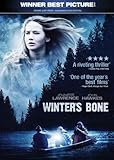 The winner of the Grand Jury Prize at Sundance, Winter’s Bone is about 17 year old “Ree” (played by Jennifer Lawrence) who’s living in terrible poverty in the Ozarks, the sole caregiver to her 2 younger siblings who have no apparent disabilties beyond being 6 and 12 years old, and a mother who is non-functioning. In some scenes, the mother seems to be catatonic or otherwise non-responsive, but in a few she is seen doing some simple tasks (i.e., folding a shirt).
The winner of the Grand Jury Prize at Sundance, Winter’s Bone is about 17 year old “Ree” (played by Jennifer Lawrence) who’s living in terrible poverty in the Ozarks, the sole caregiver to her 2 younger siblings who have no apparent disabilties beyond being 6 and 12 years old, and a mother who is non-functioning. In some scenes, the mother seems to be catatonic or otherwise non-responsive, but in a few she is seen doing some simple tasks (i.e., folding a shirt).
It is not made clear to the audience exactly what it is the mother has, how long she’s been this way, or her prospects for recovery. (Possibilities include depression or other mental illnesses, brain injury from drug use, and Multiple Sclerosis.) In one scene, Ree tells someone that her mother has been taking medication, but it’s not been helping. Her father has been missing for two weeks.
While the situation is not easy, Ree is managing things well enough, until a bail bondsman comes to the house and informs her that her father had put up the house as a bond, and if he fails to show on his court date, they are entitled to seize the house. With no alternative income or legal protections, Ree is forced to try to track down her father by asking what seems to be everyone in the immediate community.
Nearly all of them have some distant, unspecified kinship tie to her (that, the squirrel-shooting and skinning scene, and the fact that a number of people own banjos and know how to play them, initially led me to believe that this picture was set in Appalachia. I hadn’t known there was for all practical purposes an Appalachia in Missouri.) but for the most part, they are distinctly unhelpful even though they most likely are aware of her plight. Ree must tell the younger children “Never ask for what should be offered freely.”
At one point, an associate of her father’s takes her to an abandoned, burned-out meth lab and tries to sell the story that her father had died in the explosion. But she’s not buying it. She knows her father is well-known for producing methamphetamine without blowing himself up, and the weeds in that place are waist-high. She assumes her father is living but on the lam, until he misses his court date. Then, foul play becomes the most likely scenario.
Like the mountain people of the Eastern Seaboard, or the mafia in big cities, there is a “code of silence”, an omerta, if you will. The main industry of this area was meth, and because Ree’s father had planned to inform to law enforcement, persons unknown had killed him and hidden the body. Ree is faced with the difficult situation of going against the culture of her community to find out what happened to her father, and prove her father’s death to the law enforcement system. Though Ree’s immediate environment contains few people who can be said to be good role models by conventional standards, as most of the adults she encounters are either producing or using illegal drugs of one sort or another, she says “no” to drugs, though they are frequently offered to her. Perhaps because she’s intelligent enough to see the consequences of the drug trade in the faces and places she sees everyday. Eventually, she finds a way to make a compromise between her conscience, her practical needs, and the community ideal of not “being a rat”.
A scene where Ree has a talk with an Army recruiter, having seen a poster that promised a $40,000 bonus for enlisting, makes it clear that while the money would be the answer to her prayers, mainstream society, with arbitrary barriers and no exceptions, offers her few legal and legitimate ways to solve her financial and sociological problems.
